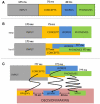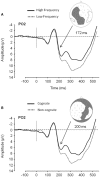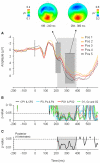Riding the lexical speedway: a critical review on the time course of lexical selection in speech production
- PMID: 22144973
- PMCID: PMC3229009
- DOI: 10.3389/fpsyg.2011.00356
Riding the lexical speedway: a critical review on the time course of lexical selection in speech production
Abstract
Speech requires time. How much time often depends on the amount of labor the brain has to perform in order to retrieve the linguistic information related to the ideas we want to express. Although most psycholinguistic research in the field of language production has focused on the net result of time required to utter words in various experimental conditions, over the last years more and more researchers pursued the objective to flesh out the time course of particular stages implicated in language production. Here we critically review these studies, with particular interest for the time course of lexical selection. First, we evaluate the data underlying the estimates of an influential temporal meta-analysis on language production (Indefrey and Levelt, 2004). We conclude that those data alone are not sufficient to provide a reliable time frame of lexical selection. Next, we discuss recent neurophysiological evidence which we argue to offer more explicit insights into the time course of lexical selection. Based on this evidence we suggest that, despite the absence of a clear time frame of how long lexical selection takes, there is sufficient direct evidence to conclude that the brain initiates lexical access within 200 ms after stimulus presentation, hereby confirming Indefrey and Levelt's estimate. In a final section, we briefly review the proposed mechanisms which could lead to this rapid onset of lexical access, namely automatic spreading activation versus specific concept selection, and discuss novel data which support the notion of spreading activation, but indicate that the speed with which this principle takes effect is driven by a top-down signal in function of the intention to engage in a speech act.
Keywords: ERPs; MEG; behavioral chronometry; language production; lexical selection; review; time course.
Figures





Similar articles
-
Spatio-temporal Dynamics of Referential and Inferential Naming: Different Brain and Cognitive Operations to Lexical Selection.Brain Topogr. 2017 Mar;30(2):182-197. doi: 10.1007/s10548-016-0504-4. Epub 2016 Jun 22. Brain Topogr. 2017. PMID: 27334987
-
Stages of lexical access in language production.Cognition. 1992 Mar;42(1-3):287-314. doi: 10.1016/0010-0277(92)90046-k. Cognition. 1992. PMID: 1582160 Review.
-
Seeing the same words differently: the time course of automaticity and top-down intention in reading.J Cogn Neurosci. 2015 Aug;27(8):1542-51. doi: 10.1162/jocn_a_00797. Epub 2015 Mar 11. J Cogn Neurosci. 2015. PMID: 25761003
-
On the time course of lexical stress priming in speech production: Behavioral and ERPs evidence from a free-stress language.Brain Res. 2016 Oct 1;1648(Pt A):202-213. doi: 10.1016/j.brainres.2016.07.018. Epub 2016 Jul 14. Brain Res. 2016. PMID: 27423519
-
From concepts to lexical items.Cognition. 1992 Mar;42(1-3):23-60. doi: 10.1016/0010-0277(92)90039-k. Cognition. 1992. PMID: 1582158 Review.
Cited by
-
Semantic Categorization of Naming Responses Based on Prearticulatory Electrical Brain Activity.J Clin Neurophysiol. 2023 Nov 1;40(7):608-615. doi: 10.1097/WNP.0000000000000933. Epub 2022 Mar 2. J Clin Neurophysiol. 2023. PMID: 37931162 Free PMC article.
-
Specifying the role of the left prefrontal cortex in word selection.Brain Lang. 2015 Oct;149:135-47. doi: 10.1016/j.bandl.2015.07.007. Epub 2015 Aug 26. Brain Lang. 2015. PMID: 26291289 Free PMC article.
-
A neuro-cognitive model of comprehension based on prediction and unification.Front Hum Neurosci. 2024 Apr 9;18:1356541. doi: 10.3389/fnhum.2024.1356541. eCollection 2024. Front Hum Neurosci. 2024. PMID: 38655372 Free PMC article.
-
The Timing of Utterance Planning in Task-Oriented Dialogue: Evidence from a Novel List-Completion Paradigm.Front Psychol. 2016 Dec 1;7:1858. doi: 10.3389/fpsyg.2016.01858. eCollection 2016. Front Psychol. 2016. PMID: 27990127 Free PMC article.
-
ERP correlates of word production predictors in picture naming: a trial by trial multiple regression analysis from stimulus onset to response.Front Neurosci. 2014 Dec 4;8:390. doi: 10.3389/fnins.2014.00390. eCollection 2014. Front Neurosci. 2014. PMID: 25538546 Free PMC article.
References
-
- Abdel Rahman R., Melinger A. (2009a). Dismissing lexical competition does not make speaking any easier: a rejoinder to Mahon and Caramazza (2009). Lang. Cogn. Process. 24, 749–76010.1080/01690960802648491 - DOI
-
- Abdel Rahman R., Melinger A. (2009b). Semantic context effects in language production: a swinging lexical network proposal and a review. Lang. Cogn. Process. 24, 713–73410.1080/01690960802597250 - DOI
LinkOut - more resources
Full Text Sources

